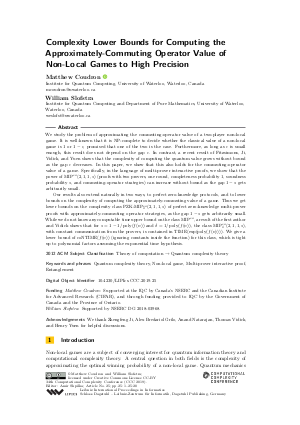@InProceedings{coudron_et_al:LIPIcs.CCC.2019.25,
author = {Coudron, Matthew and Slofstra, William},
title = {{Complexity Lower Bounds for Computing the Approximately-Commuting Operator Value of Non-Local Games to High Precision}},
booktitle = {34th Computational Complexity Conference (CCC 2019)},
pages = {25:1--25:20},
series = {Leibniz International Proceedings in Informatics (LIPIcs)},
ISBN = {978-3-95977-116-0},
ISSN = {1868-8969},
year = {2019},
volume = {137},
editor = {Shpilka, Amir},
publisher = {Schloss Dagstuhl -- Leibniz-Zentrum f{\"u}r Informatik},
address = {Dagstuhl, Germany},
URL = {https://drops.dagstuhl.de/entities/document/10.4230/LIPIcs.CCC.2019.25},
URN = {urn:nbn:de:0030-drops-108478},
doi = {10.4230/LIPIcs.CCC.2019.25},
annote = {Keywords: Quantum complexity theory, Non-local game, Multi-prover interactive proof, Entanglement}
}

 Creative Commons Attribution 3.0 Unported license
Creative Commons Attribution 3.0 Unported license












